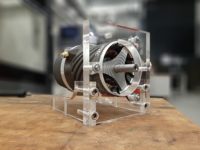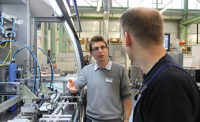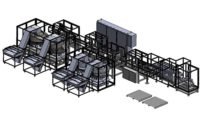Today’s cars have lots of electric motors. Indeed, one would be hard-pressed to find a late-model car with less than a dozen electric motors. Some can easily have more than 40 electric motors—and that’s not including electric vehicles.
Ensuring the safety and performance of all those electric motors is among the businesses of Marposs Corp., a manufacturer of measurement, inspection and test technologies. The company recently introduced the e.d.c. AST320/W, an automated system for testing the windings, coils and stators of electric motors in production environments. The system integrates the company’s e.d.c partial discharge measurement technology, based on capacitor coupling technology, for both AC high pot and surge tests.
Standard electrical tests are unable to identify all types of failure in an electric motor. This is because many defects produce only partial discharges, and these can only be identified using the partial discharge test method.
Partial discharge measurements detect latent defects that could generate failures in electric motors after short operating times. This is even more true for motors powered by inverter, like the ones used to power EVs.
For example, a typical fault is when a wire touches the stack of the stator. If the enamel of the wire is scratched in the contact point with the stack, the standard AC hi-pot test can identify the fault. But, as commonly happens, if the wire is well-insulated, the voltage applied during the test may not be sufficient to break the remaining insulation material. As a result, this fault may not be identified. If the measurement of partial discharges is carried out at the same time as the AC dielectric strength test, then 100 percent of these defects are always identified and filtered.
The consequence of permanent partial discharges is a gradual yet continuous weakening of the functional parts of the insulation system. This leads to a complete breakdown and failure of the electric motor.
The main advantage of the e.d.c. partial discharge technology, as compared to the more traditional antenna-type technology, is that the capacitor coupling technique is less sensitive to external noise and, therefore, more suitable for applications in production environments.
The coupling capacitor approach eliminates the need for an external sensor. Using the same cables, the partial discharge measurement test can be performed simultaneously with the standard AC high pot and surge tests, offering a more extensive verification of the components without requiring additional testing time.
The new tester shares the same HMI as all the company’s e.d.c. testing systems. This allows the user to create testing recipes that mix a variety of typical tests, such as winding resistance, insulation resistance, AC high pot tests and surge tests, as well as interacting with the external world by exchanging commands and results with the available digital I/O or OPC UA interfaces.
All measurements, parameters and testing programs are stored within the software, as are various preventive maintenance and calibration routines. Engineers have the option to upload data and software to a local area network and, if so equipped, request remote assistance. The printing of test and calibration certificates in multiple languages is supported, as is the possibility of integration with third party ERP and MES systems.
For more information on test systems, click www.marposs.com or visit the company’s booth at The ASSEMBLY Show South, which will be held April 30-May 2, 2024, at the Music City Center in Nashville, TN.
Besides test systems, you’ll find some 150 suppliers of automation, fastening tools, robotics, parts feeders, presses and other assembly technologies. For more information, visit www.assemblyshowsouth.com.




